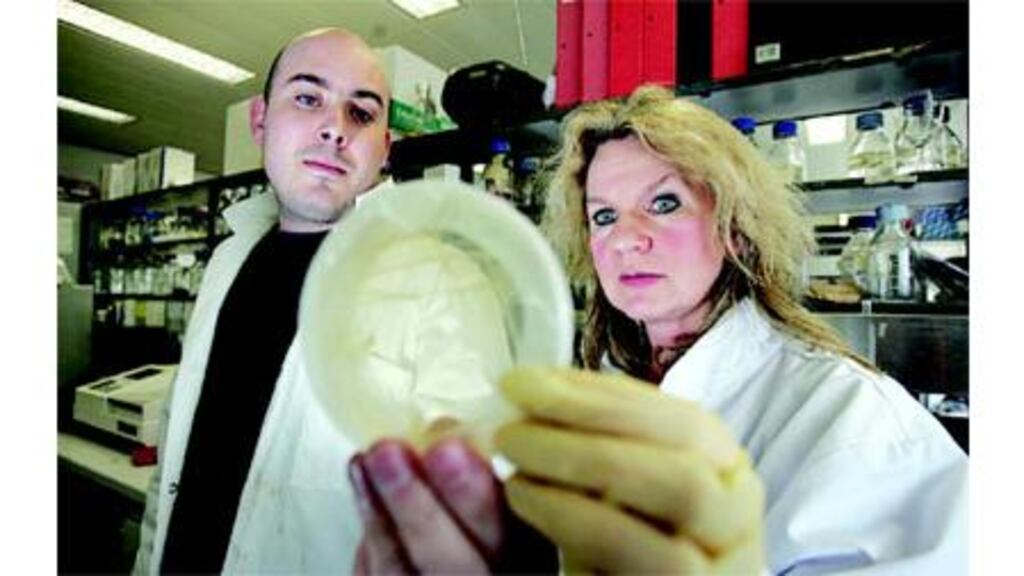An Irish team is working to find a cure for Epidermolysis bullosa (EB), a painful, often fatal skin condition, writes Dick Ahlstrom.
Skin is one of the most important defences we have against the outside world, but, for a small number of people, skin is a source of anguish. About 200 people in Ireland suffer from the inherited disorder Epidermolysis bullosa, a disease where the skin continuously blisters and breaks down.
Epidermolysis bullosa (EB) causes pain and suffering at a significant scale and many sufferers do not survive childhood. "It is a debilitating disorder. It comes in three forms and they all result in blistering of the skin," explains Dr Danny Allen, a postdoctoral research fellow in Trinity College Dublin's department of genetics.
EB causes a situation where the outer layer of skin, the epidermis, does not remain properly anchored to the underlying dermis. The slightest pressure on the skin causes it to tear and blister, leaving the sufferer in pain and unable to move.
Allen is leading a research effort at Trinity to find a cure for one form of the disease, Dystrophic EB.
He works with Dr Jane Farrar under Prof Peter Humphries, with funding coming from Debra Ireland, a dedicated research charity that raises funds specifically for the study of EB.
Debra Ireland currently supports research at Trinity, at NUI Galway and at Queen Mary's in London. It also supports a nurse liaison service, EB clinics and an information service.
Dystrophic EB comes in dominant and recessive forms, Allen explains. Recessive genetic disorders usually involve something being missing to cause a disease, for example a missing protein caused by a mutated gene.
"With the dominant form it is the actual aberrant protein itself that causes the disease," he explains. "We are looking at a gene therapy approach that first of all requires the suppression of the mutant protein and then you get in and deliver a normally functioning protein. We are the only group working on dominant dystrophic EB in the world," he says.
The protein of interest in dystrophic EB is called "collagen type VII alpha 1". It forms velcro-like hooks that bind the dermis to the epidermis, but in EB patients the protein doesn't work, Allen explains.
"The protein anchors the two layers together. When the mutated version of the protein is formed you are not getting the anchoring occurring."
The team is using one of the latest and most powerful ways of blocking the mutated gene - short interfering RNA. When a gene wants to supply a protein it first uses its DNA to produce a strand of message RNA, which in turn provides the "recipe" for the string of amino acids needed to make the protein.
RNA interference (iRNA) involves introducing short strands of interfering RNA that block the message RNA, preventing the formation of the protein.
"We are using RNA interference because it is a powerful way of being able in a specific manner to suppress the protein," says Allen.
The team has already had some success with iRNA to block the mutated collagen protein. "At the moment we have got good suppression, we can definitely suppress the protein in tissue culture."
Tissue culture tests will continue for the next few months to ensure the iRNA is working properly and in a predictable way. It may then be tested in animal models.
Separately, a US group is working on recessive dystrophic EB and ways to introduce working collagen VII alpha 1. The Trinity team may see if the two groups can combine their efforts and come up with a fully functional treatment.
Their hopes for success were given a boost a few weeks ago with the news of a spectacular therapy developed by an Italian research group working on another form of the disease, junctional EB. Their results were published earlier this month in the journal Nature Medicine.
They took skin cells from the EB patient, altered them genetically to replace a faulty laminin 5 gene and then cultured the cells for grafting back on the patient.
Nine grafts were transplanted and the new skin produced normal laminin 5 leaving the patient cured of the blistering on the transplanted areas. These transplants remain healthy a year after being grafted.
BT Young Scientist of the Year 2007 results:
Ruth Fitzpatrick of Muckross Park College, Dublin, received a special recommendation for her senior individual project, The Artificiality of Natural Habitats - Hybrid Ecosystems in a Man-made World.
Hereditary Haemochromatosis: Following last week's article on Hereditary Haemochromatosis, the Irish Haemochromatosis Association has stressed that diagnosis of the condition is very simple with an existing test, but is seldom done, with symptoms associated with the disease being diagnosed as other ailments such as diabetes. It urges people to ask their doctor about this test.









